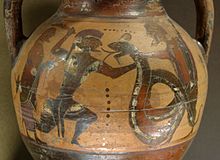Erinyes

Erinyes (/ɪˈrɪniˌiːz/; hay Erinys /ɪˈrɪnɪs/, /ɪˈraɪnɪs/;[1] tiếng Hy Lạp: Ἐρινύες, pl. of Ἐρινύς, Erinys),[2] cũng gọi là Furies là các nữ thần báo thù trong tôn giáo Hy Lạp cổ đại và trong thần thoại Hy Lạp. Trong Iliad, họ được gọi là "những nữ thần Erinyes, kẻ dưới trái đất sẽ báo thù loài người, bất kỳ ai đã thề một lời thề sai".[3] Walter Burkert còn cho rằng họ là "hiện thân của hành động tự nguyền rủa bản thân trong lời thề".[4] Tương đương với Erinyes trong thần thoại La Mã là các nữ thần Dirae. [5] Nhà văn người La Mã Maurus Servius Honoratus đã viết khoảng năm 600 sau Công nguyên rằng họ được gọi là "Eumenides" ở địa ngục, "Furiae" trên trái đất và "Dirae" trên thiên đường.[6][7]
Theo sử thi Theogony của Hesiod, khi thần Titan Cronus giết chết cha mình là Uranus và ném dương vật bị cắt đứt của Uranus xuống biển, những nữ thần Erinyes (cùng với Giants và các nữ thần Meliae) sinh ra từ những giọt máu của Uranus rơi trên trái đất, trong khi nữ thần Aphrodite được sinh ra từ máu của Uranus hòa tan với bọt biển. [8] Còn theo Aeneid của Virgil, những nữ thần Erinyes là con gái của Pluto (Hades)[9] với nữ thần bóng đêm Nox Nyx. [10] Các nữ thần Erinyes bao gồm Alecto ("bất tận" - trừng phạt tội ác vi phạm nhân phẩm đạo đức), Megaera ("thịnh nộ ghen tuông" - trừng phạt sự bội tín, không chung thủy, thất hứa, trộm cắp) và Tisiphone ("hủy diệt báo thù" - trừng phạt tội giết người), cả ba nữ thần đều cùng xuất hiện trong sử thi Aeneid.
Tham khảo[sửa | sửa mã nguồn]
- ^ “Erinyes”. Dictionary.com Unabridged. Random House. Truy cập 12 tháng Chín năm 2013.
- ^ Lidell and Scott, s.v. Ἐρινύς
- ^ Homer, Iliad 19.259–260; see also Iliad 3.278–279.
- ^ Burkert, p. 198
- ^ Chisholm, Hugh biên tập (1911). . Encyclopædia Britannica (ấn bản 11). Cambridge University Press.
- ^ Servius, Commentary on Virgil, Aeneid 4.609.
- ^ John Lemprière (1832). Lemprière's Classical Dictionary for Schools and Academies: Containing Every Name That Is Either Important or Useful in the Original Work, p. 150.
- ^ Hesiod, Theogony tufts.edu/hopper/text?doc=Hes.+Th.+173 173 & ndash; 206.
- ^ When she had spoken these words, fearsome, she sought the earth: and summoned Allecto, the grief-bringer, from the house of the Fatal Furies, from the infernal shadows: in whose mind are sad wars, angers and deceits, and guilty crimes. A monster, hated by her own father Pluto, hateful to her Tartarean sisters: she assumes so many forms, her features are so savage, she sports so many black vipers. Juno roused her with these words, saying: ‘Grant me a favour of my own, virgin daughter of Night, this service, so that my honour and glory are not weakened, and give way, and the people of Aeneas cannot woo Latinus with intermarriage, or fill the bounds of Italy (Aeneid 7.323 - Verg. A. 7.334 ).
- ^ Men speak of twin plagues, named the Dread Ones, whom Night bore untimely, in one birth with Tartarean Megaera, wreathing them equally in snaky coils, and adding wings swift as the wind (Aeneid 12.845-12, 848ff.).
Liên kết ngoài[sửa | sửa mã nguồn]
| Wikimedia Commons có thêm hình ảnh và phương tiện truyền tải về Erinyes. |
